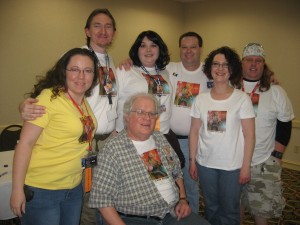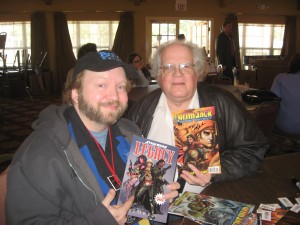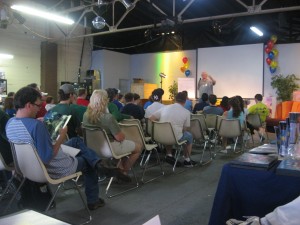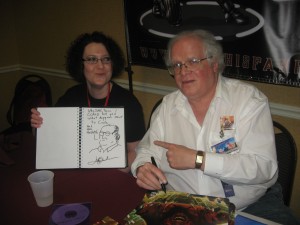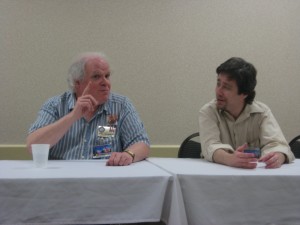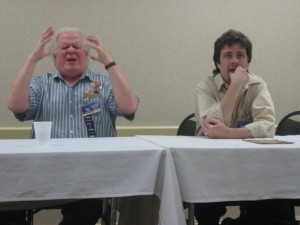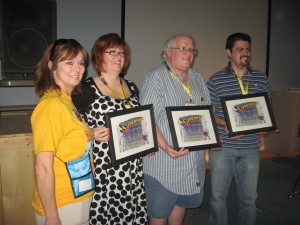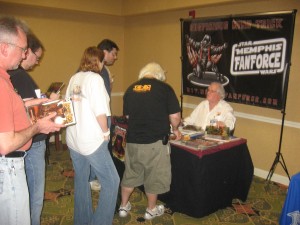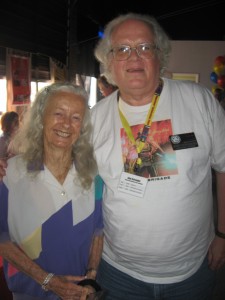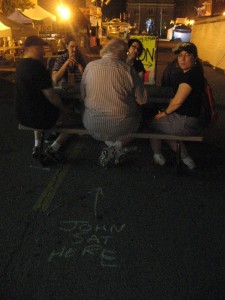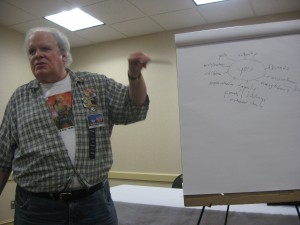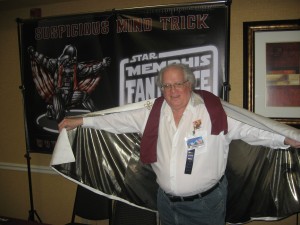Con Etiquette and the Art of the Portfolio Review Part 2
Last time in my blog “Con Etiquette and the Art of the Portfolio Review Part 1” I shared some of the advice I’ve gotten over the years, as well as my feelings on doing portfolio reviews. I’ve noticed some artists have no clue as to what a portfolio is, how to go about putting one together, or how to present it (and themselves) to get work. At times I’ve been guilty as well.
(John Ostrander with members of “The Cade Brigade” at MSC 2009)
To learn what some of the pros know I sent out some questions to some of my friends in the comics industry. First up is one of my favorite writers, and human beings- John Ostrander.
I met John for the first time in 2009 when he was the comics guest of honor at Midsouthcon, and again later that year at the Superman Celebration in Metropolis, IL. John is one of those folks that after spending 10 minutes with him you feel like you’ve known him all your life, and looking back through my comics collection that’s pretty close to being true!
(John O at the Superman Celebration in Metropolis, IL.)
HGWT: Do artists show you their portfolios at conventions or signings, and if so what are some of your pet peeves?
JO: I don’t hire artists. That’s the editors’ and art directors’ domain. Generally, I prefer not to look at portfolios at Cons. I’m not an artist so I can’t tell an artist, really, much beyond whether I like it or I don’t. Showing art to me or to most writers really is a waste of time for an artist at a con. IMO.
HGWT: What were editors you worked with on the lookout for?
JO: Storytelling. Pretty art is nice but it has to tell the story.
(John O with fellow Star Wars scribe John Jackson Miller.)
HGWT: What is some advice you’ve gotten over the years that you ended up sharing with others?
What about writers submitting to publishers at shows? Is it better to contact them directly at work or a better way?
JO: Artists CAN get work at a Con. A writer – not so much. Prepare springboards which are no more than one medium sized paragraph that gives the essence of the plot of the plot idea. It has to be typed and needs to have your personal information and no more than one page. Tailor it to a specific editor – give them story ideas about the characters that they do. Use their characters – not your own. They may not even look at new characters for concerns about being accused later of “ripping off” the potential author. TALK to the editor you have a chance to meet briefly and demonstrate you know their work by citing which story they edited was your fave. You’re looking to make a PERSONAL CONTACT which is the ONLY reason to contact an editor at a con. ASK them if they would be willing to take the storyboard sheet and don’t be offended if they don’t. If you have a small press or indie comic that you’re written and published, offer them that as well – a published author is treated differently that an unpublished one. Same for artists. Make sure what you’re giving is GOOD WORK, otherwise you’re just shooting yourself in the foot. Have a business card. Be professional and act like one; editors want to work with professionals.
(Star Wars: Legacy or Star Wars: KOTOR? We got both on one panel!)
HGWT: Is there a definite portfolio review or submissions “no-no”?
What is the best way to present their work? Average number of pieces that should be in a portfolio or submission?
Lin, I’m going to go through a number of things that covers the last three questions. What I said earlier in the writing about appearing as a PROFESSIONAL applies to artists as well. Some fundamentals – bathe. Wear clean clothes. It doesn’t have to be a suit and tie or anything like that but it should be clean and not have holes. You don’t have to fawn but be friendly. This is a job interview. First impressions count. Use a professional looking portfolio that can hold your art comfortably.
TARGET your editors. Find out who is going to be there and KNOW who they are and what books they are doing. I’ve had people proudly tell me that they were up all night finishing that most recent gem that’s at the front of the portfolio. NEVER say that. NEVER do that. Marks you as an amateur.
The pieces should all be recent work and representative of your BEST work. DON’T put in every sketch you’ve ever drawn. Just the BEST. Put the cream of your work at the front. The person reviewing your portfolio has been looking at LOTS of portfolios; they will make up their minds whether you have anything by the time they’ve seen the first or second page; everything after that either confirms or denies their first impression which is what they go with.
Keep pin-up pages to a minimum. Artists in general love to do pin-ups; they can have big WOW. But they’re not usually about storytelling and that’s what you need to sell.
Your first or second piece should be a continuity page – like a full comics page from the middle of the script. Action is good but, a few pages later, show a page of two people talking; that’s a lot of the comic. Show you know storytelling; how does one panel lead to the next. Show backgrounds, show how people dress. Give a sense of place and time. Details matter.
Character sketches are okay but it’s better of you show the character in context of a story. A cover is okay but it should look like a cover. The purpose of a cover is to get someone to pick up the book and want to buy it. A full page splash is fine but keep in mind that it is part of a story. Storytelling still matters. It’s not about what you want to draw; it’s about telling the story.
If you pencil AND ink, show the pencils on one page and then the inks on the facing page. Not on the next page; on the facing page. Don’t bother showing someone else’s inks on your pencils; you’re not trying to get them a job. You’re trying to get yourself a job. Are you ready to go to work TOMORROW? The editors are not there to extend your abilities; they are there to get their own books out on time (or reasonably close to time).
Twelve pages in your portfolio should be enough. If you’re going to a major published (DC, Marvel, Dark Horse, IDW, Dynamite) show them THEIR characters. Don’t show art about Marvel characters to a DC editor and vice versa. Yes, they should be able to tell if you can draw just from the art but the reality is, if you show a Batman page to a Marvel editor they’re liable to say, “We don’t do Batman.” — and dismiss you from any further consideration on the spot. If necessary, carry more than one portfolio or be prepared to re-organize your portfolio at the Con.
Don’t show them your own characters/concepts. That’s not what they’re looking for. They figure you can draw your own characters; the question is – can you draw THEIR characters?
Have a business card prepared with your contact information including a website where they can see more of your art. If you don’t have one of those, set one up. If you have been published, have copies of your best work and ASK if you can leave it with them. Have some reduced sized copies of the pages in your portfolio and staple them together with your card and ASK if you can leave that as well.
(Karla Ogle presenting guest writers Gail Simone, John O, and Josh Elder with their Superman of Metropolis Awards.)
IF you get work, it will probably be on a fill-in issue to begin with and probably on a tight deadline. KNOW how long it takes you to pencil a page if you’re asked; the same for inking if you’re an inker. It should take you no longer than six weeks to do a twenty-two page story; less is better. FEW people can do a full book in a month.
You are looking to show your TALENT, your SKILL, and your PROFESSIONALISM. If you get criticisms, don’t fight it, listen, ask questions if you need clarification. The editor is showing an INTEREST and that should get respect. Say THANK YOU at the end; courtesy counts and is not always common.
You are there to convince an editor that you are the solution to their problems (although you never SAY it like that). Editors are forever dealing with artists who aren’t working out, artist who are leaving, artists who flame out for whatever reason, artists who can’t hit the broad side of a deadline with a bazooka. YOU are the solution to their problems with your talent, skill, and professionalism. That’s what you want them to take away from meeting you
Remember the math – there are only so many books being published TOTAL which means there are only so many slots to fill. You have to be at least as good if not better than those who already have jobs and those who ALSO want jobs. Your purpose is to make a good impression and showcase your work.
HGWT: Are there any general convention etiquette pet peeves you have?
JO: If I’m on the way to the bathroom, don’t get in my way. Don’t ask me to talk or sign something at that point. I’ll generally sign anything that is mine with the exceptions of blank checks or contracts. If there’s a line at my table, don’t ask me to sign more than twenty five books at a time. Come back after some others have had their chance. If you have the book in a bag, take it out of the bag before giving it to me.
If you’re a writer, DON’T ask me to to read your story or proposal or whatever. I won’t do it. I don’t have the time and I won’t lay myself open to possible charges of plagiarism that can happen. OTOH, I WILL talk about writing; I love talking about writing. Sometimes I’d prefer to talk about writing than to do it; talking is always easier.
(Noel Neill/Lois Lane and John O at the Superman Celebration in Metropolis, IL.)
HGWT: Are there things you like to see people do at shows, or what thing do you get the biggest kick out of at shows?
JO: At one Con, I was away from my table and getting some lunch from the vendors at the Con. I was sitting alone when a fan who recognized me approached me and asked if I would like to join her and her friends and this table nearby. They were all big Star Wars fans. I was happy, too – I’m not keen on eating alone. I had a nice lunch and a great time talking to all of them.
(Hanging out on the midway with friends at the Superman Celebration in Metropolis, IL.)
The big reason I go to Cons is to physically meet with the fans. I know what I THINK I’ve written but fans will tell me what I’ve actually done. That feedback is great. I always try to make sure that the fans get a good experience from meeting me.
(John teaching a writers seminar at Midsouthcon.)
HGWT: Is there one piece of advice you could give creators attending conventions to get the most out of the show what would it be? Advice for fans attending?
JO: If you’re an artist, you’re at the Con for professional reasons. Know who is going to be there and when. Target the panels you want to attend. Talks about art or writing may do you more good than a movie panel. Make a list and, after the Con, see how much of it you accomplished. For fans – decide what you want to do and who/what you most want to see. And just enjoy yourself.
(John enjoying himself at Midsouthcon in Memphis.)
I’d like to thank John for taking the time to answer my questions and share his advice with us. He is currently writing Star Wars: Dawn of the Jedi for Dark Horse Comics, and serves up advice and more at ComicMix. If you see him at a con stop and say hi- just make sure he’s not on a bathroom break! (My bladder and I can empathize!)
Part 3 with some advice from artist Jamal Igle to come soon…stay “tooned”.
Lin
